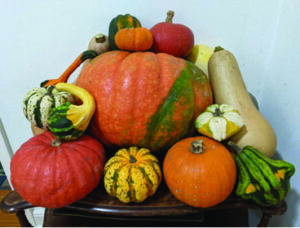By Debbie Roland and
Emmy Ulmschneider
Master Gardeners
Did you know that Native Americans grew and ate pumpkins, their seeds and blooms for thousands of years? From that simple discovery came the squashes and pumpkins that have spread around the world and are enjoyed by so many people.
Native to North and South America, all squashes and pumpkins, from zucchini and spaghetti squash to butternut squash and ornamental gourds are members of the same genus, Cucurbita. The difference in all these cultivars is where and who developed them. But everyone has distinct cultivars and traditional recipes that offer health benefits and are packed with nutrition.
They are traditionally harvested in October and are used to make desserts, breads and soup. Americans carve pumpkins at Halloween but the tradition began in Ireland where turnips or potatoes were carved. When Irish immigrants arrived here they started carving pumpkins and a new twist to an old tradition began.

Plant pumpkins in May and leave lots of room between plants because they like to spread. They are heavy feeders so use a fertilizer starting out and then side dress them when the vines start to run. Their lush vigorous growth attracts insects so watch for squash bugs. They take between 90 and 120 days to grow and are ripe when they are bright orange in color, have a hard rind and a woody stem. Carefully cut the stem leaving several inches of stem on the pumpkin. When you carve them, save the seeds the roast them for a traditional snack, or dry and save seeds for next year’s garden.
It is always a bit sad that these edible decorations end up in a dumpster. This year make a sustainable change. When the decorating is over, bake them like you would squash and enjoy them with dinner. If you have one that you won’t eat, compost it for your garden or donate it to a farm friend to feed to their livestock or chickens.
When you enjoy your pumpkin pie at Thanksgiving, give thanks for an amazing plant with American origins that has travelled the world.
For more information, call the AgriLife office at 498-4071 in Odessa or at 686-4700 in Midland or visit aggie-horticulture.tamu.edu or westtexasgardening.org.




